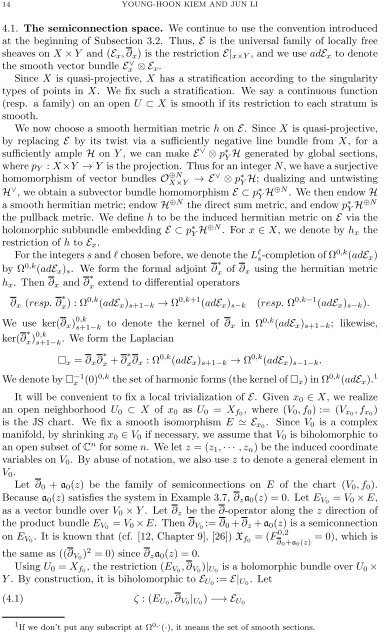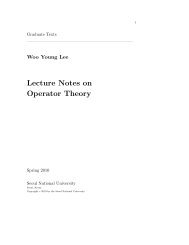Categorification of Donaldson-Thomas invariants via perverse ...
Categorification of Donaldson-Thomas invariants via perverse ...
Categorification of Donaldson-Thomas invariants via perverse ...
You also want an ePaper? Increase the reach of your titles
YUMPU automatically turns print PDFs into web optimized ePapers that Google loves.
14 YOUNG-HOON KIEM AND JUN LI4.1. The semiconnection space. We continue to use the convention introducedat the beginning <strong>of</strong> Subsection 3.2. Thus, E is the universal family <strong>of</strong> locally freesheaves on X × Y and (E x , ∂ x ) is the restriction E| x×Y , and we use adE x to denotethe smooth vector bundle Ex ∨ ⊗ E x .Since X is quasi-projective, X has a stratification according to the singularitytypes <strong>of</strong> points in X. We fix such a stratification. We say a continuous function(resp. a family) on an open U ⊂ X is smooth if its restriction to each stratum issmooth.We now choose a smooth hermitian metric h on E. Since X is quasi-projective,by replacing E by its twist <strong>via</strong> a sufficiently negative line bundle from X, for asufficiently ample H on Y , we can make E ∨ ⊗ p ∗ Y H generated by global sections,where p Y : X×Y → Y is the projection. Thus for an integer N, we have a surjectivehomomorphism <strong>of</strong> vector bundles O ⊕NX×Y→ E ∨ ⊗ p ∗ Y H; dualizing and untwistingH ∨ , we obtain a subvector bundle homomorphism E ⊂ p ∗ Y H⊕N . We then endow Ha smooth hermitian metric; endow H ⊕N the direct sum metric, and endow p ∗ Y H⊕Nthe pullback metric. We define h to be the induced hermitian metric on E <strong>via</strong> theholomorphic subbundle embedding E ⊂ p ∗ Y H⊕N . For x ∈ X, we denote by h x therestriction <strong>of</strong> h to E x .For the integers s and l chosen before, we denote the L l s-completion <strong>of</strong> Ω 0,k (adE x )by Ω 0,k (adE x ) s . We form the formal adjoint ∂ ∗ x <strong>of</strong> ∂ x using the hermitian metrich x . Then ∂ x and ∂ ∗ x extend to differential operators∂ x (resp. ∂ ∗ x) : Ω 0,k (adE x ) s+1−k → Ω 0,k+1 (adE x ) s−k (resp. Ω 0,k−1 (adE x ) s−k ).We use ker(∂ x ) 0,ks+1−k to denote the kernel <strong>of</strong> ∂ x in Ω 0,k (adE x ) s+1−k ; likewise,ker(∂ ∗ x) 0,ks+1−k. We form the Laplacian□ x = ∂ x ∂ ∗ x + ∂ ∗ x∂ x : Ω 0,k (adE x ) s+1−k → Ω 0,k (adE x ) s−1−k .We denote by □ −1x (0) 0,k the set <strong>of</strong> harmonic forms (the kernel <strong>of</strong> □ x ) in Ω 0,k (adE x ). 1It will be convenient to fix a local tri<strong>via</strong>lization <strong>of</strong> E. Given x 0 ∈ X, we realizean open neighborhood U 0 ⊂ X <strong>of</strong> x 0 as U 0 = X f0 , where (V 0 , f 0 ) := (V x0 , f x0 )is the JS chart. We fix a smooth isomorphism E ≃ E x0 . Since V 0 is a complexmanifold, by shrinking x 0 ∈ V 0 if necessary, we assume that V 0 is biholomorphic toan open subset <strong>of</strong> C n for some n. We let z = (z 1 , · · · , z n ) be the induced coordinatevariables on V 0 . By abuse <strong>of</strong> notation, we also use z to denote a general element inV 0 .Let ∂ 0 + a 0 (z) be the family <strong>of</strong> semiconnections on E <strong>of</strong> the chart (V 0 , f 0 ).Because a 0 (z) satisfies the system in Example 3.7, ∂ z a 0 (z) = 0. Let E V0 = V 0 × E,as a vector bundle over V 0 × Y . Let ∂ z be the ∂-operator along the z direction <strong>of</strong>the product bundle E V0 = V 0 × E. Then ∂ V0 := ∂ 0 + ∂ z + a 0 (z) is a semiconnectionon E V0 . It is known that (cf. [12, Chapter 9], [26]) X f0 = (F 0,2 = 0), which is∂ 0+a 0(z)the same as ((∂ V0 ) 2 = 0) since ∂ z a 0 (z) = 0.Using U 0 = X f0 , the restriction (E V0 , ∂ V0 )| U0 is a holomorphic bundle over U 0 ×Y . By construction, it is biholomorphic to E U0 := E| U0 . Let(4.1) ζ : (E U0 , ∂ V0 | U0 ) −→ E U01 If we don’t put any subscript at Ω 0,·(·), it means the set <strong>of</strong> smooth sections.













